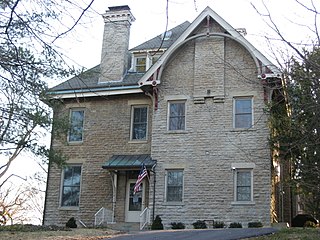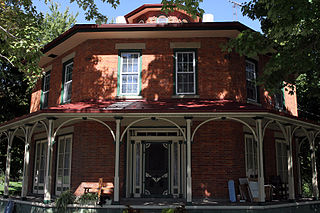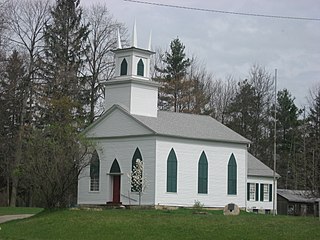
The Richard H. Mitchell House is a historic residence in Cincinnati, Ohio, United States. Built of stone throughout, this large house was designed by prominent Cincinnati architect Samuel Hannaford. Converted into a school, the house has been named a historic site.

Twin Oaks, also known as the "Robert Reily House", is a historically significant residence in the city of Wyoming, located near Cincinnati in the southwestern corner of the U.S. state of Ohio. Constructed in the middle of the nineteenth century, it was the home of Robert Reily, one of the leading citizens of early Wyoming. Its heavy stone architecture features a mix of two important architectural styles of the period, and it has been named a historic site.

The Demas Adams House is a historic residence in the Columbus-area city of Worthington, Ohio, United States. Constructed for a second-generation settler, it retains an extensive degree of its original 1810s architecture, and it has been named a historic site.

The John Hosford House is a historic octagon house located along U.S. Route 20 in Monroeville, Ohio, United States. Built at an unknown point in the mid-nineteenth century, it has been named a historic site.

Windsor Mills Christ Church Episcopal is a historic former church building in Windsor Township, Ashtabula County, Ohio, United States. Built in the 1830s, it features a distinctive combination of two different architectural styles, and it has been named a historic site.

The Church of Our Saviour is a historic Episcopal parish in the village of Mechanicsburg, Ohio, United States. Founded in the 1890s, it is one of the youngest congregations in the village, but its Gothic Revival-style church building that was constructed soon after the parish's creation has been named a historic site.

The Mechanicsburg Baptist Church is a historic church in the village of Mechanicsburg, Ohio, United States. Constructed for a Methodist congregation in the late nineteenth century, the building was taken over by Baptists after the original occupants vacated it, and it has been named a historic site.

Second Baptist Church is a historic church building in the village of Mechanicsburg, Ohio, United States. Constructed in the mid-19th century, it is the oldest church in the village, and it has been named a historic site.

St. Paul's African Methodist Episcopal Church is a historic church in Urbana, Ohio, United States. Built in the Greek Revival style in 1876, it is home to a congregation that was founded in the mid-1820s.

Mechanicsburg United Methodist Church is a historic Methodist congregation in the village of Mechanicsburg, Ohio, United States. Founded in the early nineteenth century, it is the oldest church in the village, and as such it has played a part in the histories of other Mechanicsburg churches. Its fifth and present church, a Gothic Revival-style structure erected in the 1890s, has been named a historic site.

St. Joseph's Church is a historic Catholic church in the city of Springfield, Ohio, United States. Established in the 1880s to serve southeastern Springfield's growing Catholic population, it uses a tall Romanesque Revival church building, which was designed by a leading city architect; the building has been named a historic site.

The former St. Paul's Episcopal Church is a historic church in Cleveland, Ohio, United States. Built for an Episcopal parish by a well-known architect, it became a prominent component of the city's wealthy Millionaire's Row, due to its grand architecture. Although vacated by its original owners in the 1920s, it was soon bought by a Catholic monastic group that occupies it into the present day. It was named a historic site in 1980.

First United Methodist Church is a historic congregation of the United Methodist Church in downtown London, Ohio, United States. Founded in London's earliest years, the congregation worships in a historic church building that was built in the 1890s.

The Odd Fellows Hall is one of the oldest non-residential buildings in the city of Hilliard, Ohio, United States. Located in the center of the city, it was constructed long before Hilliard's rapid growth of the twentieth-century. It has been named a historic site.

The Samuel Danford Farm is a historic complex of buildings in northeastern Noble County, Ohio, United States. Located near the village of Summerfield, the complex comprises six buildings and one other site in an area of approximately 7.5 acres (3.0 ha).

Zion Episcopal Church is a historic Protestant Episcopal parish in the village of Monroeville, Ohio, United States. Constructed in the 1860s in the regionally unusual Carpenter Gothic style, the church building has been named a historic site.

St. Paul's Episcopal Church is a historic Episcopal parish in Medina, Ohio, United States. Formed in the 1810s as Medina's first church, it worships in a high Gothic Revival church building constructed in the 1880s, which has been named a historic site.

St. Paul's Episcopal Church is a historic Episcopalian church in Fremont, a city in the northwestern part of the U.S. state of Ohio. Built in the 1840s and expanded multiple times in the following decades, it has been named a historic site for its distinctive architecture.

Groveport United Methodist Church is a historic church in the village of Groveport, Ohio, United States. Established in the 1830s, this congregation of the United Methodist Church worships in an early twentieth-century building that has been named a historic site.

St. John's Episcopal Church was founded in 1804 by James Kilbourne, the same Episcopal deacon who founded the city in which the church resides, Worthington, Ohio, and for whom a nearby high school and middle school are named. It was the first Episcopal church built west of the Allegheny Mountains, built between 1827 and 1831, with Kilbourne Hall constructed in 1927 and the church's Early Education Center in 1962.






















